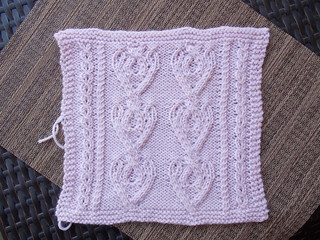It's a Chain of Hearts! There's a song in there somewhere.
The second block from the afghan is the Barbara Selesnick square, I think I may have actually done this one as my fifth or sixth square because it is also a bit on the small side and I know if I had seen that happen twice in a row I would have begun to default to knitting everything a needle size up. This one though, is definately on the recommended needle size of 8, which is also about the largest needle size I would ever use with Cascade 220 superwash. The square as it measures at the moment is about ten inches tall and 11 inches wide. So it should be fine in the afghan itself once there are other squares to hold it in place.
As far as knitting this one goes, I don't remember any real issues. The charts are an every other row, 4 row and 20 row repeat so it isn't difficult to figure out where you were when you left off. I think sometimes people over think stringing charts together. The only row numbers I bother to really track (if I track them at all) are the main motif rows. The others just cue off of that. Is the row I'm on even and a multiple of four? Great then I'm on row four of Chart B, even but not? then I'm on row two. You really only need the if/then statements if you are lost: which in this one wouldn't really happen because it's pictorial.
Speaking of being pictorial, I'd like to talk about the overall design theory of this block because it's one of the two main types of designs you will find in the afghan. I call them the "snapshot" and the "picture frame" block theories. In the "snapshot" blocks, we get multiple repeats of a vertical design that could easily be used for a strip afghan. In the "picture frame" blocks we normally get a centered, closed, single motif.
I will admit that I think every block I omitted is in the latter category, as I think with those blocks you either really love them or really hate them.



